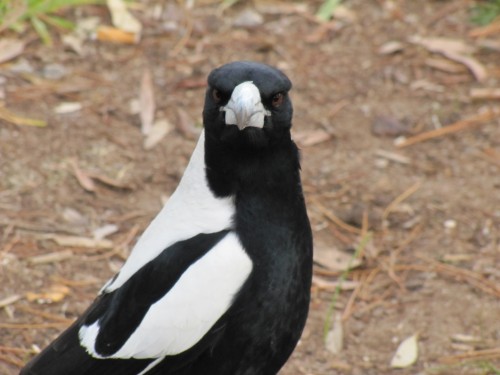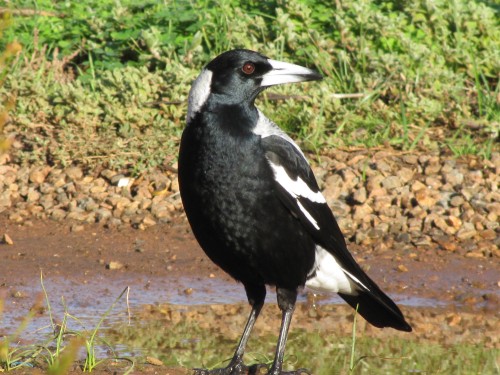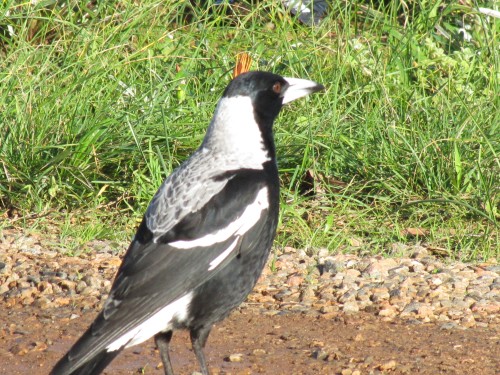Do Blackbirds Swoop? How to Deal with Aggressive Bird Behaviour
Do Blackbirds Swoop?
This intriguing question was posted by Jill on one my earlier articles. I assured her in my reply that I have never heard of this species swooping humans.
You have nothing to fear where Common Blackbirds are concerned. I have never experienced swooping with this species. In fact, they are usually rather timid and will readily fly away from humans. I have checked on the internet and found no recorded instances of Common Blackbirds swooping humans.
I also read through the article on Common Blackbirds in HANZAB (Handbook of Australian New Zealand and Antarctic Birds Vol.7) and there is no mention of this behaviour. HANZAB is THE authority on Australian birds and is a compilation of all research done on birds in this region, including a comprehensive overview of all the relevant published literature on birds.
UPDATE: Since writing this article I have had many comments about Blackbirds swooping. Many have claimed that they do swoop. These comments have always come from American readers. I was writing about the Common Blackbird, an introduced species in Australia. They come from Europe and are not related to several species found in America which do swoop. The Red-winged Blackbird of north and central America is very aggressive I believe. Some readers may also have been confused by my comments, thinking I was talking about the Grackle.
Magpies and Lapwings
Most Australians know about the problem with Australian Magpies and swooping. They need to be given a wide berth when nesting. What many people do not know is that Masked Lapwings (also called Spur Winged Plovers) can inflict a nasty wound. Keep away from their nests or young is the message they are giving. On most occasions their attack is 95% bluff and injuries are rare. Last spring there was a very unusual news report on television showing footage of Magpie Larks attacking humans near the Festival Centre in the CBD of Adelaide. This is the only occasion I have known of this species swooping like their bigger cousins.
Kookaburras and Butcherbirds
Other species that may occasionally swoop include Kookaburras (one individual once took a sausage from a barbecue I was cooking). I once had an opportunistic Grey Butcherbird snatch a sandwich from my hand while on a picnic. In both these cases they were swooping for food – not attacking me. Gave me a fright though.
Geese, Ducks and Swans
In parks and gardens as well as zoos and wildlife parks, any of the species of geese can get a little aggressive. This is often as a result of too many people feeding them. Many species of ducks can also get this way. I’ve even known Black Swans to act aggressively. In most cases they are after food; they are not intending to harm people.
Pelicans
I have heard of an instance of an Australian Pelican eating a small dog on the riverfront at Renmark in South Australia. I’m not sure if this is a true story or an urban myth, but pelicans would be quite capable of this. What I have witnessed was rather scary. We had visited the bakery at Mannum and were sitting on a seat near the riverfront eating our lunch. A pelican came up to us and almost snatched a sausage roll from the hand of my daughter-in-law. Having a pelican a metre away staring you directly in the eye is very unnerving.
Emus and Cassowaries
Many years ago while visiting a zoo in the SW of Western Australia I had another unnerving encounter, this time with an Emu. I was in a walk through enclosure containing ducks, geese, emus and kangaroos. One Emu took a liking to my camera lens and my glasses. Being followed by an Emu – no – harassed is a better word – was distressing, especially as the said Emu constantly tried to peck either my glasses or the camera lens. I was so constantly under attack that I had to quickly leave the enclosure, much to the amusement of my family!
The Southern Cassowary of northern Queensland has a reputation for being aggressive towards humans. I don’t have personal experience of this species, but I know that when I do visit that region, I’m going to be wary of the cassowary!
Ibises and Gulls
Gulls and picnics seem to go together. Especially when you produce some fish and chips. It is as if you’ve put up a huge neon sign saying “Come to the feast.” Again, this is as a result of feeding by humans and not a direct attack to harm. Having said that, it is intimidating and annoying to have a Silver Gull standing on your picnic table 30cm away from your lovely chips. In some parts of Australia, Ibises are a major problem too, snatching food from children in particular. Our larger Ibis species are almost as large as a toddler learning to walk. Scary stuff for a youngster.
Willie Wagtail
Willie Wagtails are generally loved by all Australians and is one of our most recognisable birds. What most people do not realise is that these endearing little creatures can be very bold and aggressive when there are babies in a nest nearby. Our resident Willie Wagtails have given us a little tweak on the head if we venture too close to the nest. And they are not too slow to attack birds much bigger than themselves; even our largest eagle, the Wedge Tail, is not immune from harassment.
Honeyeaters
Honeyeaters are not known for their aggression towards humans. If you get too close to their nest they will let you know, scalding you incessantly from a nearby branch. However, they can be very bold. Many years ago a friend in Port Augusta related to me an occasion when a honeyeater landed on his shoulder and tried to pluck a hair from his rather ample beard. While this incident is not a display of aggression, it does show how courageous they can be.
Eagles
There have been a few recorded instances of people being attacked by eagles, hawks and other raptors. Only last year I was aggressively swooped by what I think was a Brown Falcon. I can’t be sure because I didn’t hang around too long. I was invading his territory so I beat a hasty retreat. He didn’t contact any part of me but it was a little unnerving.
How to Deal With Aggressive Bird Behaviour
- Give the birds space – keep away from their nest or their young. Think about how you would react if a large monster invaded your home. They are protecting their offspring so respect their space. If there is a magpie nesting on your usual walking route, try to take an alternative route until the nesting has finished.
- Wear protective clothing – this is particularly so with swooping magpies. Wear a hat or helmet to avoid injury. Some people say that painting large eyes on the back of a helmet, hat or cap helps to deter magpies from swooping.
- Don’t feed native birds – if everyone followed this rule there wouldn’t be a problem but it is probably too late for that. If you are having a picnic, don’t be tempted to throw food scraps to the gulls of ducks or whatever is nearby. Just one chip or bread crumb thrown at one bird will often result in dozens of birds flocking to your picnic ready for a handout. In the case of Gulls, it could result in hundreds surrounding your picnic spot.
- Carry a stick – I’ve proved this to be effective with magpies swooping. Carry a stick above one’s head as you walk through a magpie nesting zone. This deters them from attacking your head. Decorating the stick with ribbons can add to the distraction level.
- Carry a flag – this one is mainly for cyclists. Mount a pole on your bike with a flag at the top. It will help motorists see you too!
Readers’ Contributions:
I invite readers to leave their comments about their experiences with aggressive birds.
- Which birds have swooped you?
- How have you been harmed by birds?
- What about birds in other countries? Do they swoop or attack?
- What solutions to aggressive bird behaviour can you share with readers of this blog?
UPDATE:
- Readers on this blog have contributed many interesting comments – click on the comments section below this post.
- I have written a followup article called A Bit on the Nose. This post quotes in full an amusing email sent to the the Birding-Aus forum today. Special thanks to Bill for permission to quote the email in full.
Related articles and links:
- Common Blackbirds – my article that started me on this post.
- ProBlogger – this article has been submitted to the Group Writing Project “How to…” being run by Darren Rowse on ProBlogger.
The problem of swooping magpies
It’s magpie swooping time again.
At this time of year people in many places around Australia are ducking for cover. It is magpie swooping time again. Around July and onwards our Australian Magpies start building or refurbishing their nests ready for the breeding season. Once the female has laid to eggs she is the only one to hatch them. Meanwhile, the male keeps guard over his territory.
Territorial
This species is highly territorial and disputes over their patch are hotly contested. On our five acre (2 hectare) property we have three intersecting territories, so the conflict can sometimes get quite boisterous. Once nesting commences, these bird wars calm down. You could say that they are real life “angry birds”.
Attacks
The fighting doesn’t always end there, however. While the female is sitting on the eggs, or the young are being fed while still in the nest, the male can be very aggressive in guarding his territory against anything, or anyone, he sees as a threat to the success of his progeny. Animals – including dogs, cats, foxes – other birds, walkers, gardeners, joggers and anyone misguided enough to venture within a hundred metres or so of the nest are all fair targets. Cyclists are a particular object of attack.
Damage
The male magpie will usually wait until the target has passed by, and will then attack from behind, a swift, smooth, nearly silent swoop aimed at the head. A swoosh of the wings and a few snaps of the beak from less than a metre behind is often the only warning one gets. By then it is too late. If contact is made the result can be both frightening and bloody. Their sharp beak can inflict a nasty break in the skin, and in a worst case scenario they have been known to damage an eye.
Preventing being swooped
So – what can one do to prevent getting swooped? I recently read this great list which was published here in South Australia in Weekend Plus: a digital magazine for seniors.
“We do need to take care around them because they have sharp beaks and claws and if they make contact, they can draw blood.
“The good news is that swooping season only lasts about six weeks, beginning when the eggs hatch and finishing when the young birds leave the nest.
“The best way to avoid being swooped is to change your route if possible, as they’ll only swoop within 50m of their nests.”
More tips for surviving the spring swoop
- Avoid making eye contact with magpies.
- Walk, don’t run past their nests.
- Travel in groups where possible as swooping birds generally target individuals.
- Carry an open umbrella or wear sunglasses and a broad-brimmed hat.
- If you’re riding a bike, walk your bike through magpie territory or attach a flag to the back that is taller than your head.
- Don’t wave your arms or shout – this just proves you are a threat to the nest.
- If you know of a swooping magpie, put up a sign to warn others.
Further reading:
- Do Blackbirds swoop? How to deal with aggressive birds.
- A bit on the nose – a humorous close encounter with a bird
- Magpies behaving badly
- Bird wars
- Aggressive bird behaviour in the garden
New Holland Honeyeater v House Sparrow
Some time ago I wrote about bird aggression in the garden. On that occasion there was a dispute between our resident Willie Wagtail and a New Holland Honeyeater.
The New Holland Honeyeaters are currently feeding two chicks in a nest in our garden quite close to our house. They are constantly busy feeding their offspring.
Several days ago I noticed that a female House Sparrow ventured into the Melaleuca bush where the nest is located. The New Holland Honeyeater sent it off pronto, chasing it vigorously around the garden. Both landed on the ground and the honeyeater confronted the sparrow.
The response from the House Sparrow was something I had never seen this species display before; it raised its tail in a fan-like manner. This bold move seemed to work because the honeyeater backed off and soon resumed tending to its young.
It happened too quickly for me to photograph.
Related articles:
Bird Rescue: New Holland Honeyeater
From time to time we have birds crash into one of our windows. This is a regular and common problem throughout the world it seems. It is one of the dangers presented to our bird life by our modern forms of architecture, from the humble country cottage like our home through to large high-rise buildings and everything in between.
In our situation, we have several large picture windows that perfectly reflect the surrounding garden at certain times of the day. Birds flying along see what they think is a continuation of the garden, but in fact they are seeing a reflection. Crashes into the glass are inevitable.
In most cases, the affected birds sit still for a few moments before flying off, probably with a headache and very puzzled expression on their faces. We have had the occasional death and this is always regrettable and sad.
Yesterday it was the turn of one of our many New Holland Honeyeaters to suffer momentarily. I heard the thump against the glass and went outside to investigate. The poor bird was on the ground not moving. At first I thought it had died, but then I noticed shallow breathing.
I put the unfortunate bird on a nearby garden table and left it to recover. A few minutes later it flew of, hopefully a little wiser. While it was recovering I took advantage of having a bird at close quarters for several photos.
Related Articles:
Bird Wars
On a regular basis I have witnessed aggressive behaviour in birds. On a previous post I wrote about the conflict in our garden between a Willie Wagtail and a New Holland Honeyeater. The New Holland Honeyeaters seem to be aggressive towards many species. So is the Red Wattlebird, often seen chasing away other species from its favoured feeding plants.
Willie Wagtails are well known for taking on much larger birds, even as large as a Wedge-tailed Eagle which is many times its size. This is especially so during nesting time. Magpies get very aggressive during breeding season, the male defending the nest from all who dare come near the nest, humans included.
On fewer occasions I have observed a group of one species attacking a single bird from another species. Mobbing of Owls by honeyeaters, for example, is relatively common. Less common, in my experience, is a group actually doing harm to a single bird. While driving recently near our local racecourse I saw about a dozen Common Starlings attacking a Spotted Turtledove. The details are sketchy because I was concentrating on driving and couldn’t stop to observe further. The hapless turtledove seemed destined for a nasty demise. Perhaps the lady walking her dog towards the scene of the crime disturbed the attackers and gave it a reprieve. Whatever happened, I saw no body there a few hours later as I passed the same spot.
Related Articles:








